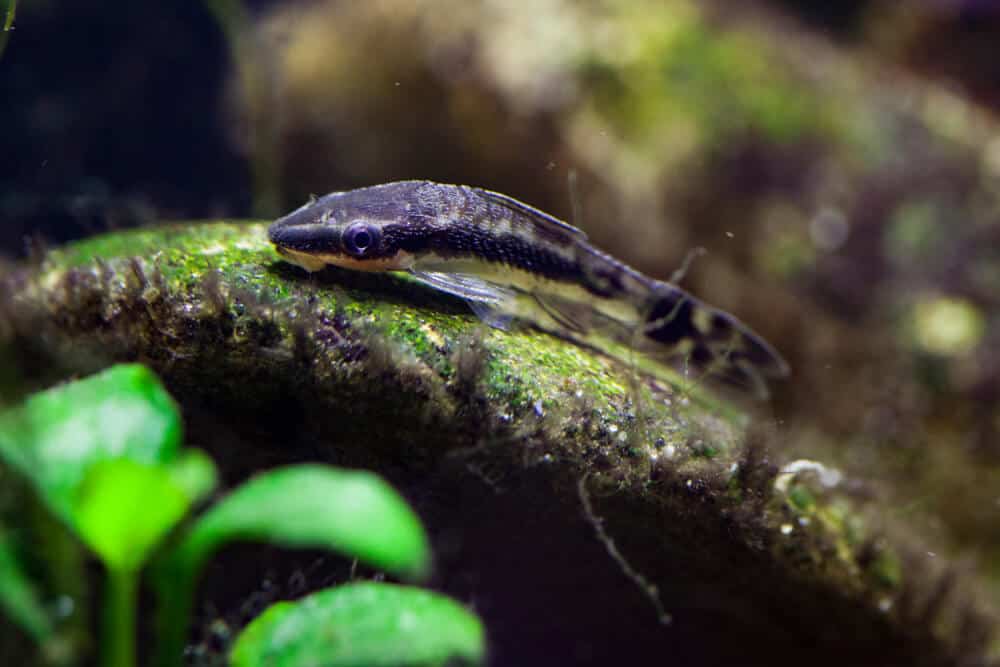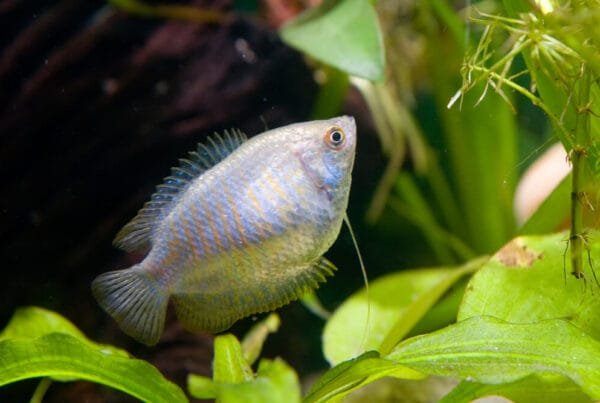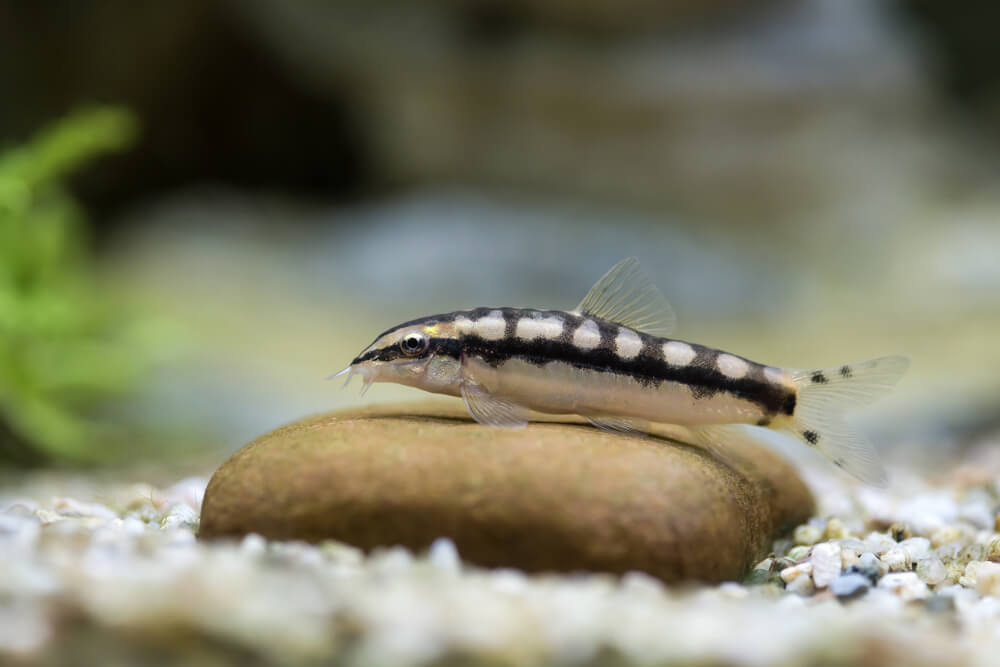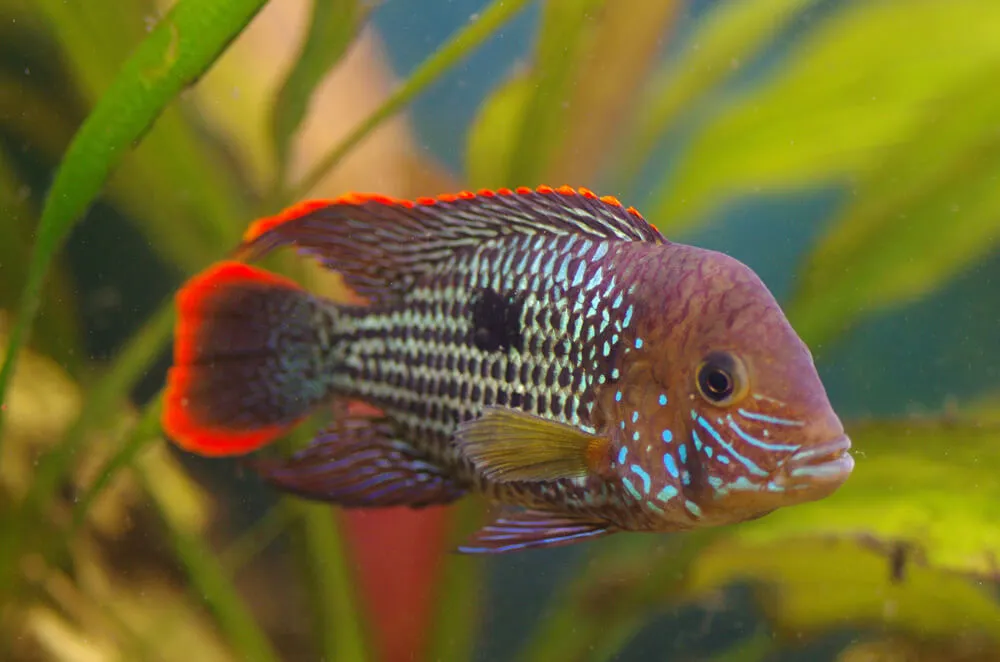Otocinclus Catfish is a member of the catfish family with 22 recognized species. These freshwater fish are relatively small, with long slender bodies, and feature various colors.
They are generally a peaceful and agile type of fish which makes them a firm favorite among many hobbyists.
Otocinclus are excellent scavengers making them an integral addition to a freshwater aquarium. In the wild, these fish thrive off of feeding on algae by attaching themselves to driftwood, rocks, and other surfaces.
These fish are also referred to as Otos, Oto Cats, Oto Catfish, Dwarf Ottos, and Dwarf Suckers, to name a few. Moreover, Otocinclus affinis and Macrotocinclus affinis are Otocinclus Catfish’ scientific names.
In this in-depth care guide, you will learn several important things about keeping Otos in an aquarium environment.
You’ll get to know basic care, tank setup and requirements, diet and feeding, breeding, and common health concerns.
Otocinclus Catfish Care
Introduction To Care
Otocinclus catfish are small, peaceful, and lively freshwater fish that do not require intensive care. They feed off algae and would pretty much thrive in a well-vegetated tank environment.
For many fishkeepers, Otos are great additions to an aquarium as they are typically hardy species. However, it is important to know that keeping Oto Cats in a freshwater aquarium may not be as easy as it sounds.
Oftentimes, many Otos die shortly after being put in a tank even though they looked perfectly healthy and well prior to being transferred.
This is why knowing the right tank conditions is extremely important to help these fish live longer.
Generally, Otos must be put in a well-established, clean, and stable aquarium environment for them to have the highest chance of survival.
They typically flourish in a well-vegetated tank with good algae growth; these fish like to feed on soft algae.
Water Requirements
Otocinclus Catfish must be added to an established tank with soft, slow-flowing, and well-oxygenated water.
The water temperature must be between 72°F and 79°F with a pH level of 6.8 to 7.5. You must be mindful of the sudden temperature changes in the aquarium water as it can stress out the Otos and it may even cause death to these fish.
The aquarium water must also be steadily moving, and well-filtered, and the Ammonia and Nitrates level must be extremely low.
Lastly, to keep the water hygienic, make sure to do fractional water changes regularly. This will also keep the tank water’s buffering capacity.
Diet And Nutrition
Oto cats are naturally herbivores – their diet mainly consists of algae, plant matter, and bacteria. An aquarium with lush vegetation and good algae growth is a great way to imitate Otos’ natural habitat in the wild.
Apart from algae, Otos also like to feed on blanched vegetables including spinach, lettuce, and zucchini. Feed them tiny pieces of these veggies in the tank and remove any uneaten portions after 24 hours.
Additionally, if the tank consists of a large group of Oto cats along with algae-eating species, they may run short of algae growth quickly.
For this reason, supplementing them with algae wafers would help solve food scarcity issues in the aquarium.
Given that Otos are natural scavengers and would typically survive by feeding on algae growth and plant matter in the aquarium, it is recommended to only feed them commercial foods or vegetable shreds no more than 2 or 4 times a week.
Otocinclus Catfish Habitat
In the wild, Oto cats thrive on waters with stable surfaces. They dwell on driftwoods and rocks where algae growth is prominent and vegetation is well established.
Moreover, their natural habitat in the waters has good sunlight access. To help these fish survive in captivity, it is important for hobbyists to replicate their natural place of dwelling as much as they can.
Tank Size
A group of about 4 to 6 Otocinclus Catfish must be kept in a tank that is at least 10 gallons in size. However, if you plan on growing your collection of Otos, a 20-gallon tank would be ideal.
Substrate
In terms of subtracting your aquarium for Otos, a soft sandy substrate is definitely the safest option. It is important to choose a smooth substrate without sharp protruding rocks as Otos are scaleless and might easily scratch themselves with rough surfaces.
On the other hand, when choosing a substrate, make sure to choose one that is suitable for your aquarium plants.
Plants And Decorations
As mentioned, Otocinclus Catfish thrive in a well-vegetated environment. Thus, having a good variety of plants in an aquarium is important to give these fish a suitable dwelling place in captivity.
Here are a few plants you can put in your Otos’ tank.
- Java Fern
- Anubias
- Cabomba
- Echinodorus
Tank decorations, on the other hand, are also important for keeping Otos in an aquarium as these act as their hiding and grazing spots.
Here is a list of good decoration pieces to add to your Oto Cats’ aquarium.
- Rocks
- Driftwood
- Caves
Compatible Tank Mates
As Otocinclus Catfish are small species of fish, it is highly important to avoid putting them in the same tank with large fish species, especially the aggressive and territorial types. Other small fish are also not compatible with Otos such as Discus and Angel Fish because of their aggressive tendencies.
Essentially, the best tank mates for Oto Cats are other small species with a gentle temperament. Avoid putting these fish with larger species, even ones that are calm and peaceful in nature as your Otos will be at risk of being eaten.
Here is a rundown of compatible tank mates for Otos.
#1. Fish
As mentioned, small fish species with calm temperaments cohabit best with Otocinclus Catfish. Some of these species include Bristlenose Plecos, Boraras, Pygmy Cory, Dwarf Gouramis, Panda Garra, Neon Tetras, Royal Farlowella, Medaka Ricefish, Dwarf Ember Barbs, Rasboras, Endlers, and Guppies.
Although small in size, Bettas, Angelfish, Siamese Algae Eater, and Paradise Fish are more aggressive than other species of fish. Thus, it is better to skip them when choosing other fish as tank mates for Otocinclus Catfish.
#2. Snails
Otos can cohabit harmoniously with freshwater snails. Both species have a calm and peaceful temperament; thus, they will not be a bother to one another.
Some of the top snail species chosen by many hobbyists which also make great companions for Otos include the Ramshorn snail, Nerite snail, Lava snail, Mystery snail, Horned Armor snail, Rabbit snail, Assassin snail, Trumpet snail, and Japanese Trapdoor snail.
When keeping Otocinclus Catfish and snails in one tank, keep in mind that both species feed on algae.
If your tank does not have adequate amounts of algae, both species may starve due to food scarcity. Therefore, it is important to supplement the aquarium with commercial algae wafers and tiny vegetable shreds.
#3. Dwarf Shrimps
Dwarf Shrimps are quite challenging to keep in an aquarium simply because they are easy prey for other fish. They can also be easily annoyed by other territorial and aggressive species in a tank.
However, Otocinclus Catfish is the perfect tank mate for Dwarf shrimp. Both species are peaceful in nature and do not differ much in size.
Some of the best options for dwarf aquarium shrimps to put with Otos include Ghost shrimp, Bamboo Shrimp, Amano Shrimp, Caridina shrimp, Neocaridina shrimp, Tiger shrimp, Pinto shrimp, and Indian Whisker shrimp.
Just like snails, shrimps are also algae-eaters and they will compete with your Oto Cats in scavenging algae around the aquarium. Amano shrimps are especially voracious algae feeders.
Having too many shrimps in your tank will starve your Otos in the long run.
Incompatible Tank Mates
Any fish species that are large in size or any that have an aggressive temperament is definitely not a suitable tank mate for Otocinclus Catfish. In addition, all kinds of crayfish and crabs are also a firm pass as they are most definitely going to prey on Otocinclus Catfish.
Providing Otos with a peaceful environment is one of the best ways to keep them healthy, and happy, and live a longer life in an aquarium.
Otocinclus Catfish Breeding
Introduction To Breeding
Otocinclus Catfish is generally easy-to-maintain fish that requires moderate care level.
However, in terms of breeding, Otos are absolutely challenging to deal with. In fact, many hobbyists give up halfway through the breeding process.
But if you would like to give breeding Oto Cats a shot, here are a few things to keep in mind.
Breeding Conditions
In order to successfully breed Otos, you must first ensure that the breeding tank is in the most suitable condition. Certain water parameters such as pH, temperature, and hardness have to be at the most ideal levels.
The water temperature has to be at around 78.8°F in order for the fish to mate and reproduce without difficulties. Slightly raising the water temperature will help in facilitating the breeding process of your Otos.
Moreover, it is also important to decorate the breeding tank with some aquarium plants. These will help in holding the bundles of eggs after they have been produced.
Spawning
Generally, female Otocinclus Catfish can lay around 50 eggs in one spawning session. Once the female fish has finished laying her eggs, the male fish will release his sperm onto the eggs to fertilize them.
Once the fertilization process is done, the eggs will be left sticking to nearby surfaces or plants where they have been laid and fertilized.
Otocinclus Catfish in general, do not have parental instincts so they will most likely not look after their eggs afterward. Even so, Otos typically will not eat their eggs so they should be just fine.
Raising Fry
If the fertilization process was done right and successfully, the eggs will eventually hatch in the following few days and you will soon see the fry swimming around the tank searching for food.
Otocinclus Catfish fry normally feeds on algae as well as other microbes that are present in the tank.
To maximize the fry’s survival chances, it is crucial to prepare a suitable tank environment. A fifty percent water change every week is recommended to ensure a hygienic environment for the fry to live and grow in.
Otocinclus Catfish Species
Otocinclus Catfish or Otos, for short, is a South American native species renowned for being exceptional algae eaters. These hardy fish make a great addition to aquariums with small, non-aggressive species as they can help keep the tank tidy by feeding on algae growth.
Generally, Oto Cats have an elongated body structure that broadens in the middle and slims down toward the head and tail. There are currently 22 known species of Otocinclus Catfish.
Below is a rundown of some of the commonly found Oto Cats in aquariums to date.
#1. Otocinclus Macrospilus
This species is commonly known as dwarf Otocinclus Catfish. They can be easily distinguished from other Otos due to their brown-toned bodies with a few dark patches that scatter across the fish’s tail line and rear end.
Oto macrospilus mimics an eardrum-like structure which gives it a one-of-a-kind appearance.
#2. Otocinclus Cocama
You can easily point out this species of Otocinclus Catfish from the others because of its zebra-like appearance. This Oto features black and white stripe patches across its body making them look like a zebra.
#3. Otocinclus Vittatus
This species of Oto Cats can be distinguished through the dark brown stripes that run laterally across its body. These stripes run across its head all the way to its tail.
#4. Otocinclus Vestitus
This species of Oto Cat holds some similarities to the Oto Macrospilus given that both species feature some dark patches across its body. However, Otocinclus vestitus has a gray-toned body with a dark brown lateral line extending across its head towards its tail.
#5. Otocinclus Mangaba
Otocinclus Mangaba can be distinguished from the others through its apparent absence of median abdomen plates in between its lateral abdomen plates. This Oto Cat also features a prominent dark spot situated at the base of its caudal fin.
This species of Oto Cat is not as commonly found in aquariums as the other ones mentioned on this list.
#6. Otocinclus Mimulus
This Otocinclus Catfish species features a pale body with dark patches scattered across. This Oto Cat mimics the appearance of Corydoras Diphyes – a species that is not considered to be prey by other species due to its bony armor-like structure.
Because of its resemblance to Corydoras Diphyes, Otocinclus Mimulus have fewer tendencies to be preyed upon by others.
Otocinclus Catfish Health
Otos are a great addition to aquariums are they are easy to care for provided that they are added to an appropriate tank environment with suitable water parameters. With proper care and nutrition, Otos live for a handful of years.
However, despite being hardy fish that requires less maintenance, Oto Cats can also be prone to common fish diseases especially if proper tank conditions are not met.
Listed below are three of the most common diseases Otos can be afflicted with.
#1. White Spots
This disease affects a wide range of fish including Otocinclus Catfish. White spot disease is often caused by an infection from protozoa.
This disease will cause irritation throughout the fish’s body which leads to extreme discomfort. In addition, the infected fish may also have a hard time breathing and choose to isolate itself from the others.
Symptoms
The visible signs of this disease include white spots scattered across the body and gills. These spots are very itchy so you may see your fish scrubbing its body against surfaces.
Treatment And Prevention
To prevent the disease from affecting the other fish in the aquarium, you must isolate the infected ones in a separate tank.
Elevate the water temperature to 86°F and add some aquarium salt to the water to prevent further bacterial growth.
#2. Gold Dust
This disease is among the most common types of parasitic disease among Oto Cats.
Gold Dust disease involves a parasite that attaches itself to the fish’s gills and skin. The victim will then have visible yellow spots all throughout its body.
Symptoms
Symptoms of Gold Dust disease include loss of appetite, labored breathing, irritation, and lethargy.
Treatment And Prevention
To avoid the other Otos and species in the same aquarium from catching this disease, isolate the infected fish in a separate tank. Gold Dust disease can be treated with copper sulfate, methylene blue, malachite green, and acriflavine.
#3. Cotton Mold
Also known as Saprolegniasis, Cotton Mold disease is another parasitic ailment that can afflict Otos.
This disease is caused by the Saprolegnia fungus. The infected fish will have fluffy cotton-like growths throughout its body, gills, and fins.
Symptoms
Fish suffering from Cotton Mold disease will show symptoms of pale skin and sunken eyes.
Treatment And Prevention
Cotton Mold disease, or Saprolegniasis, is a more serious ailment for any fish species and therefore, the infected fish must be given appropriate treatment as soon as possible.
This disease can be treated with the use of substances such as formalin, malachite green, and hydrogen peroxide.
Cotton Mold disease can be prevented by keeping water quality at optimum conditions.
Otocinclus Catfish FAQ
General Questions
Q: How many Otos can you keep in one tank?
Otocinclus Catfish are shoaling fish and love to socialize with other Otos. For this reason, it is recommended to keep at least 6 in the same tank.
However, 10 to 15 Otos in an aquarium is a much better option.
Q: Are Oto Cats great for beginner hobbyists?
Oto Cats are low-maintenance fish that require easy care as long as they are kept in a well-vegetated aquarium with the optimum water parameter levels. In other words, Otos are a great choice for newbie aquarists.
Care Questions
Q: What are the appropriate food items for Otos?
As Otocinclus Catfish are naturally herbivores, the appropriate diet for them includes foods such as algae, vegetable shreds, and commercial algae wafers.
Habitat Questions
Q: What is the best tank size for Oto Cats?
The minimum tank size for 6 Otos is 10 gallons. However, if you are planning to add up to 15 of them in one tank, a 20-gallon tank is the best suitable size.
Breeding Questions
Q: At what age can you breed Oto Cats?
Otos reach maturity and will be able to reproduce at the age of six to nine months.
Q: Do Oto Cats eat their eggs?
Although Otos generally don’t possess any parental instincts, they typically leave their eggs after the fertilization process. In addition, these fish don’t feed on their eggs.
Otocinclus Catfish Products
Foods And Treats
While Otos are herbivores and would feed on natural foods such as plant matter and algae, they also love to feed on some commercial food products such as algae wafers. They can also be given tiny slices of fresh vegetables.
Equipment And Supplies
Otocinclus Catfish require a tidy and hygienic aquarium environment for a higher chance of survival. For this reason, a good filtration system is an integral part of Oto Cats’ tank.
Tank Decorations
For greater chances of survival, you must replicate Otocinclus Catfish’ natural habitat in the wild.
This means the aquarium should have a wide variety of vegetation, a few hiding and grazing spots, and a soft sandy substrate at the bottom.
Conclusion
Tank setup, appropriate water parameters, proper diet and feeding, breeding, and common diseases are the top factors any aquarist must know before deciding to keep Otocinclus Catfish in a tank.
Oto Cats are undeniably among the best fish species any hobbyist, of any level, would consider adding to their collection. Otos are hardy fish that require less maintenance; thus making them a breeze to care for.
Whether you are thinking about getting Otocinclus Catfish or you are already a keeper of these awesome fish, we’d like to know your thoughts.
Do leave a comment below sharing your experience with Otos. And tell us what you think about this in-depth guide for Otocinclus Catfish care.
You may also ask any questions related to this topic if you have anything in mind.







